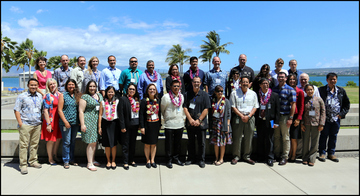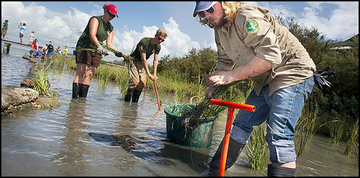HIGHLIGHTS

Celebrating
Habitat Month at NOAA Fisheries
We’re celebrating Habitat Month at NOAA
Fisheries during July. Join us all month as we celebrate the benefits of
habitat conservation to fish and wildlife, communities, and the economy. Office
Director Pat Montanio shares her thoughts via a new Leadership
Message. Other featured content this week includes Habitat Conservation
Basics. Finally, check out our habitat conservation photo contest (entries
due July 17).
Law
Enforcement Priorities Document – Open for Public Comment
By July
28, please submit your comments on the NOAA Office of Law Enforcement’s
draft Priorities Document for FY 2018–2022. OLE sets priorities on a 5-year
timeline to guide strategic planning and focus enforcement assets where they
are most needed.
Seafood
Import Monitoring Program Roundtables
NOAA Fisheries will be
hosting a series of roundtables around the nation July 13–25 to discuss the U.S. Seafood Import Monitoring Program’s
traceability data reporting and record-keeping requirements before they become
mandatory in 2018. The roundtables will be held in Long Beach, Seattle, Newark,
and Miami, and they will address topics relevant to foreign exporters and U.S.
domestic importers of seafood species covered by the program.
Endangered
Species Recovery Guidelines – Extended Comment Period
By August
28 (formerly June 30), please submit your comments on proposed revisions to
the Recovery Plan Preparation and Implementation Priorities and Recovery Plans
contained in the 1990 Endangered Species Listing and Recovery Priority
Guidelines. The proposed revisions are aimed at better prioritizing limited agency
resources for species recovery.

Pollock
Fare Better than Expected in Warm Water
The 2014–2016 warm spell in the Bering Sea
brought concerns that pollock populations would plummet, as happened during the
last warm spell (2001–2005.) A new study suggests that juvenile pollock used alternative
resources during this recent warm spell that helped buffer the ill effects of
the warming.
Traditional Fishing Practices in Alaska
Fishing is an integral part of life for
Alaska Native women in Bristol Bay. NOAA Fisheries scientists visited local
communities surrounding Bristol Bay to collect first-hand accounts of the life
experiences of these remarkable fishermen as part of a NOAA Preserve America
Grant, with additional support from the Pacific States Marine Fisheries Commission
and the Bristol Bay Native Association.
West Coast
North
Pacific Right Whale Status Review
NOAA Fisheries initiated a 5-year review of
the North Pacific right whale under the Endangered Species Act. We are
requesting any scientific and commercial data on this population that have
become available since the last status review in 2012. Submissions and comments
are due July 31.
 International
Partnership for Ecosystem-Based Fisheries Management
Last week, the Pacific Islands Fisheries
Science Center, Pacific Islands Regional Office, and NOAA’s Office of Law
Enforcement welcomed delegates from the Philippines for a “peer exchange” in
Honolulu. The exchange focused on sharing fisheries management, science, and
enforcement approaches across these two countries.
June’s Monk Seal
of the Month
The Monk Seal of the Month for June was R006,
also known as Mama Eve. We don’t know her exact age, but we do know Mama Eve
has made a significant contribution to the population of monk seals on
Kalaupapa Peninsula on Molokai. We can trace 56 seals—including pups,
grand-pups, and great-grand-pups—back to her.
Southeast

NOAA Announces
2017 GulfCorps Grant Awardee
NOAA is committed to restoring the Gulf of
Mexico following the Deepwater Horizon oil spill. Through the RESTORE Council,
NOAA and federal and state partners are working to establish a “GulfCorps”
program that will provide the labor for on-the-ground restoration projects
through the Gulf states. The Nature Conservancy has been recommended to receive
$7 million from RESTORE funding to establish this GulfCorps program.
South Atlantic Spawning
Special Management Zones
NOAA Fisheries announced a final rule for
Amendment 36 to the South Atlantic Snapper-Grouper Fishery Management Plan. The
actions in Amendment 36 and the final rule will implement spawning special
management zones to protect reproducing fish and their habitats. The zones will
take effect July 31.
Greater Atlantic

From
Beaches to the Bottom of the Sea, Microplastics Are Everywhere
Each year, millions of tons of plastic debris
enter the ocean—often in the form of “microplastics,” pieces of plastic less
than 5 millimeters in size. Fish, shellfish, and other marine animals ingest
the microplastics as they feed. Chemists at the Northeast Fisheries Science
Center’s Sandy Hook Lab are working to trace the sources of different
microplastics and better understand their impact on the marine environment.
Chesapeake
Bay Office Biennial Report to Congress
NOAA’s Chesapeake Bay Office recently sent
their Biennial Report to Congress, highlighting work accomplished by the
program in fiscal years 2015 and 2016. The report provides an overview of
recent efforts toward restoring oysters, advancing fisheries science,
supporting environmental education, and more.
Digital
Media as a Research Tool
Read about the latest examples of how and why
scientists from the Northeast Fisheries Science Center use cameras to answer
big research questions. Digital photography and videography are playing new
roles in collecting data on plankton, fish eggs, fish behavior, oysters, and
surfclams.
State Water Scallop Exemptions – Open for Comment
By July
14, please submit your comments on a proposed rule that would revise the
State Waters Exemption Program under the Atlantic Sea Scallop Fishery
Management Plan. The proposed rule would allow vessels holding both a
Massachusetts state scallop permit and certain federal scallop permits to
continue fishing in state waters once federal limits had been reached.
Proposed
Blueline Tilefish Rule – Open for Comment
By July
28, please submit your comments on a proposed
rule to add blueline tilefish to the Mid-Atlantic
Fishery Management Council’s Golden Tilefish Fishery Management Plan. Since
2011, recreational and commercial blueline tilefish catch has been increasing
steadily in the Greater Atlantic Region. The rapid rise in unregulated harvest
represented a risk to the long-term sustainability of the stock.
|